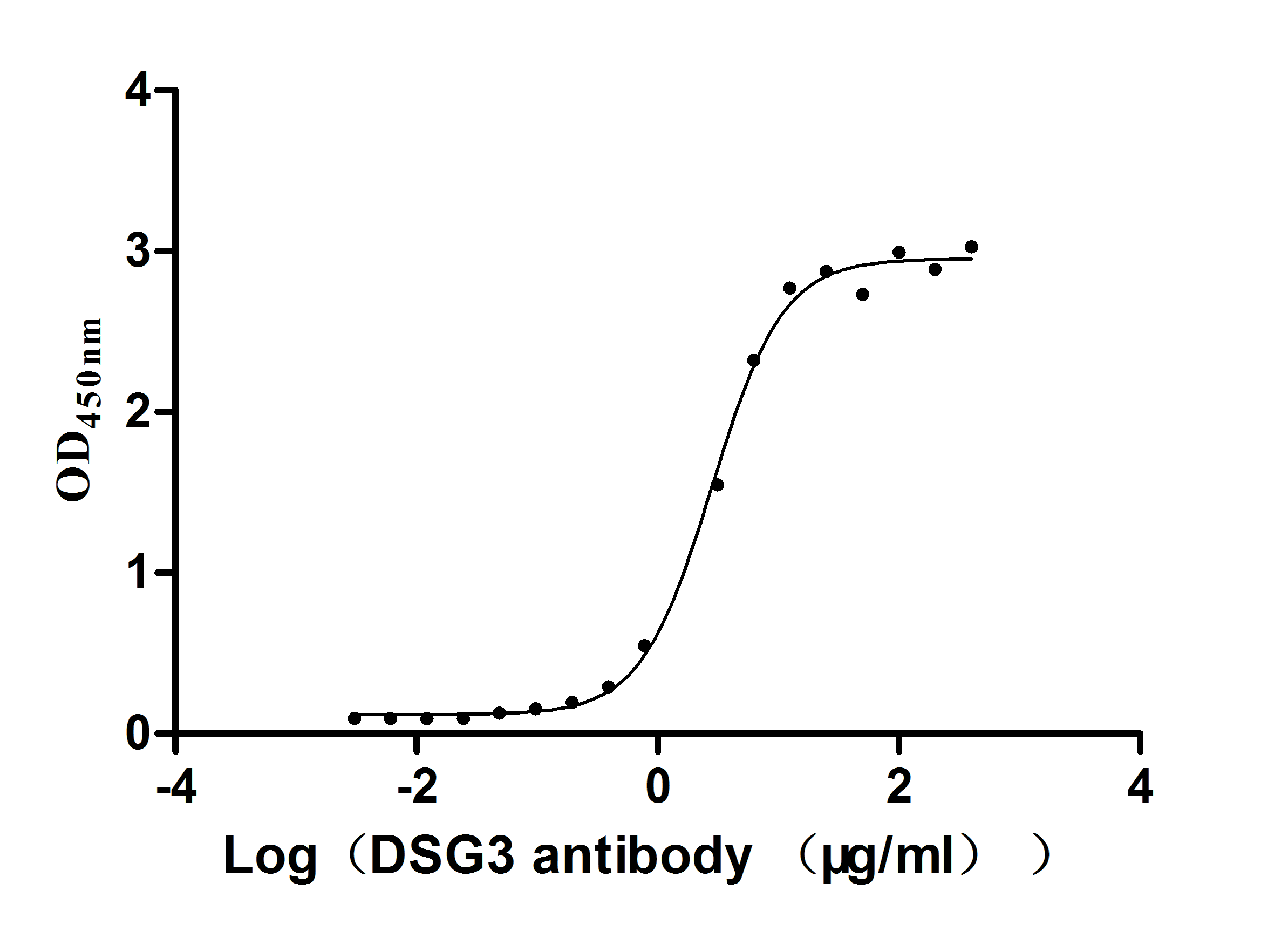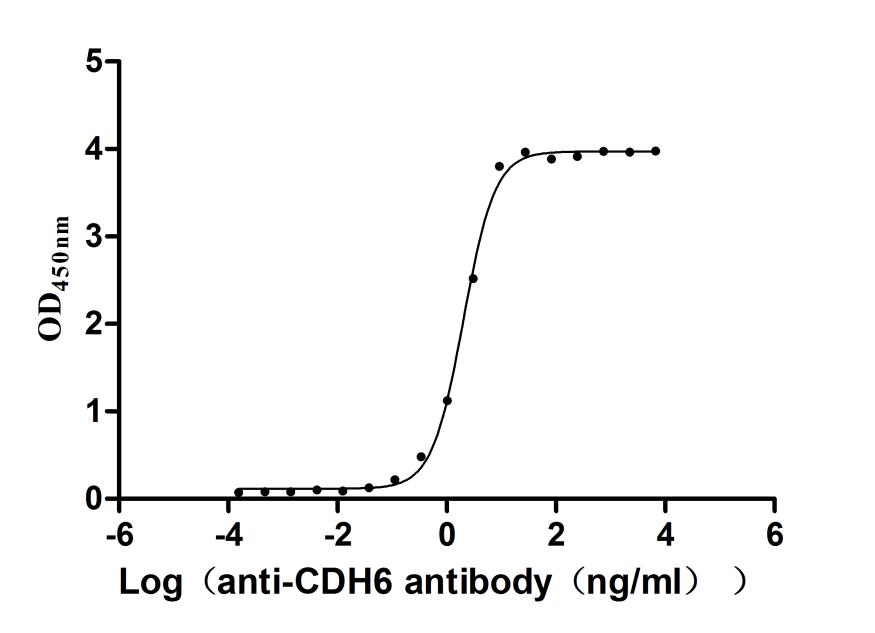Recombinant Mouse Heterogeneous nuclear ribonucleoprotein U (Hnrnpu)
-
中文名称:小鼠Hnrnpu重组蛋白
-
货号:CSB-YP840857MO
-
规格:
-
来源:Yeast
-
其他:
-
中文名称:小鼠Hnrnpu重组蛋白
-
货号:CSB-EP840857MO
-
规格:
-
来源:E.coli
-
其他:
-
中文名称:小鼠Hnrnpu重组蛋白
-
货号:CSB-EP840857MO-B
-
规格:
-
来源:E.coli
-
共轭:Avi-tag Biotinylated
E. coli biotin ligase (BirA) is highly specific in covalently attaching biotin to the 15 amino acid AviTag peptide. This recombinant protein was biotinylated in vivo by AviTag-BirA technology, which method is BriA catalyzes amide linkage between the biotin and the specific lysine of the AviTag.
-
其他:
-
中文名称:小鼠Hnrnpu重组蛋白
-
货号:CSB-BP840857MO
-
规格:
-
来源:Baculovirus
-
其他:
-
中文名称:小鼠Hnrnpu重组蛋白
-
货号:CSB-MP840857MO
-
规格:
-
来源:Mammalian cell
-
其他:
产品详情
-
纯度:>85% (SDS-PAGE)
-
基因名:Hnrnpu
-
Uniprot No.:
-
别名:Hnrnpu; Hnrpu; Heterogeneous nuclear ribonucleoprotein U; hnRNP U; Scaffold-attachment factor A; SAF-A
-
种属:Mus musculus (Mouse)
-
蛋白长度:Full Length of Mature Protein
-
表达区域:2-800
-
氨基酸序列SSSPVNVKK LKVSELKEEL KKRRLSDKGL KADLMDRLQA ALDNEAGGRP AMEPGNGSLD LGGDAAGRSG AGLEQEAAAG AEDDEEEEGI AALDGDQMEL GEENGAAGAA DAGAMEEEEA ASEDENGDDQ GFQEGEDELG DEEEGAGDEN GHGEQQSQPP AAAAQQQPSQ QRGAGKEAAG KSSGPTSLFA VTVAPPGARQ GQQQAGGDGK TEQKGGDKKR GVKRPREDHG RGYFEYIEEN KYSRAKSPQP PVEEEDEHFD DTVVCLDTYN CDLHFKISRD RLSASSLTME SFAFLWAGGR ASYGVSKGKV CFEMKVTEKI PVRHLYTKDI DIHEVRIGWS LTTSGMLLGE EEFSYGYSLK GIKTCNCETE DYGEKFDEND VITCFANFET DEVELSYAKN GQDLGVAFKI SKEVLADRPL FPHVLCHNCA VEFNFGQKEK PYFPIPEDCT FIQNVPLEDR VRGPKGPEEK KDCEVVMMIG LPGAGKTTWV TKHAAENPGK YNILGTNTIM DKMMVAGFKK QMADTGKLNT LLQRAPQCLG KFIEIAARKK RNFILDQTNV SAAAQRRKMC LFAGFQRKAV VVCPKDEDYK QRTQKKAEVE GKDLPEHAVL KMKGNFTLPE VAECFDEITY VELQKEEAQK LLEQYKEESK KALPPEKKQN TGSKKSNKNK SGKNQFNRGG GHRGRGGFNM RGGNFRGGAP GNRGGYNRRG NMPQRGGGGG SGGIGYPYPR GPVFPGRGGY SNRGNYNRGG MPNRGNYNQN FRGRGNNRGY KNQSQGYNQW QQGQFWGQKP WSQHYHQGYY
-
蛋白标签:Tag type will be determined during the manufacturing process.
The tag type will be determined during production process. If you have specified tag type, please tell us and we will develop the specified tag preferentially. -
产品提供形式:Lyophilized powder
Note: We will preferentially ship the format that we have in stock, however, if you have any special requirement for the format, please remark your requirement when placing the order, we will prepare according to your demand. -
复溶:We recommend that this vial be briefly centrifuged prior to opening to bring the contents to the bottom. Please reconstitute protein in deionized sterile water to a concentration of 0.1-1.0 mg/mL.We recommend to add 5-50% of glycerol (final concentration) and aliquot for long-term storage at -20℃/-80℃. Our default final concentration of glycerol is 50%. Customers could use it as reference.
-
储存条件:Store at -20°C/-80°C upon receipt, aliquoting is necessary for mutiple use. Avoid repeated freeze-thaw cycles.
-
保质期:The shelf life is related to many factors, storage state, buffer ingredients, storage temperature and the stability of the protein itself.
Generally, the shelf life of liquid form is 6 months at -20°C/-80°C. The shelf life of lyophilized form is 12 months at -20°C/-80°C. -
货期:Delivery time may differ from different purchasing way or location, please kindly consult your local distributors for specific delivery time.Note: All of our proteins are default shipped with normal blue ice packs, if you request to ship with dry ice, please communicate with us in advance and extra fees will be charged.
-
注意事项:Repeated freezing and thawing is not recommended. Store working aliquots at 4°C for up to one week.
-
Datasheet :Please contact us to get it.
靶点详情
-
功能:DNA- and RNA-binding protein involved in several cellular processes such as nuclear chromatin organization, telomere-length regulation, transcription, mRNA alternative splicing and stability, Xist-mediated transcriptional silencing and mitotic cell progression. Plays a role in the regulation of interphase large-scale gene-rich chromatin organization through chromatin-associated RNAs (caRNAs) in a transcription-dependent manner, and thereby maintains genomic stability. Required for the localization of the long non-coding Xist RNA on the inactive chromosome X (Xi) and the subsequent initiation and maintenance of X-linked transcriptional gene silencing during X-inactivation. Plays a role as a RNA polymerase II (Pol II) holoenzyme transcription regulator. Promotes transcription initiation by direct association with the core-TFIIH basal transcription factor complex for the assembly of a functional pre-initiation complex with Pol II in a actin-dependent manner. Blocks Pol II transcription elongation activity by inhibiting the C-terminal domain (CTD) phosphorylation of Pol II and dissociates from Pol II pre-initiation complex prior to productive transcription elongation. Positively regulates CBX5-induced transcriptional gene silencing and retention of CBX5 in the nucleus. Negatively regulates glucocorticoid-mediated transcriptional activation. Key regulator of transcription initiation and elongation in embryonic stem cells upon leukemia inhibitory factor (LIF) signaling. Involved in the long non-coding RNA H19-mediated Pol II transcriptional repression. Participates in the circadian regulation of the core clock component ARNTL/BMAL1 transcription. Plays a role in the regulation of telomere length. Plays a role as a global pre-mRNA alternative splicing modulator by regulating U2 small nuclear ribonucleoprotein (snRNP) biogenesis. Plays a role in mRNA stability. Component of the CRD-mediated complex that promotes MYC mRNA stabilization. Enhances the expression of specific genes, such as tumor necrosis factor TNFA, by regulating mRNA stability, possibly through binding to the 3'-untranslated region (UTR). Plays a role in mitotic cell cycle regulation. Involved in the formation of stable mitotic spindle microtubules (MTs) attachment to kinetochore, spindle organization and chromosome congression. Phosphorylation at Ser-58 by PLK1 is required for chromosome alignement and segregation and progression through mitosis. Contributes also to the targeting of AURKA to mitotic spindle MTs. Binds to double- and single-stranded DNA and RNA, poly(A), poly(C) and poly(G) oligoribonucleotides. Binds to chromatin-associated RNAs (caRNAs). Associates with chromatin to scaffold/matrix attachment region (S/MAR) elements in a chromatin-associated RNAs (caRNAs)-dependent manner. Binds (via RNA-binding RGG-box region) to the long non-coding Xist RNA; this binding is direct and bridges the Xist RNA and the inactive chromosome X (Xi). Binds the long non-coding H19 RNA. Binds to SMN1/2 pre-mRNAs at G/U-rich regions. Binds to small nuclear RNAs (snRNAs). Binds to the 3'-UTR of TNFA mRNA. Also negatively regulates embryonic stem cell differentiation upon LIF signaling. Required for embryonic development. Binds to brown fat long non-coding RNA 1 (Blnc1); facilitates the recruitment of Blnc1 by ZBTB7B required to drive brown and beige fat development and thermogenesis.
-
基因功能参考文献:
- we demonstrated that HNRNPU functions as a major factor maintaining 3D chromatin architecture, suggesting important roles of NM-associated proteins in genome organization. PMID: 29254943
- We found that heterogeneous nuclear ribonucleoprotein U (hnRNP U) is essential for the expression of Avp and Vip. Loss of one copy of the Hnrnpu gene resulted in fragmented locomotor activities and disrupted metabolic rhythms. Hnrnpu(+/-) mice were more active than wild-type mice in the daytime but more inactive at night. PMID: 29128567
- findings provide conclusive evidence for the essential role of hnRNP U in heart development and function and in the regulation of alternative splicing. PMID: 26039991
- Macrophage expression of hnRNP U was induced by TLR stimulation. hnRNP U knockdown attenuated & overexpression increased TLR-induced expression of TNF-alpha, IL-6 & IL-1beta. hnRNP U bound to the mRNA of these cytokines via the RGG motif. PMID: 22345668
- Data report that endogenous SAF-A is involved in regulation of Oct4 expression, binds the Oct4 proximal promoter in ES cells, and dissociates from the promoter upon early differentiation induced by LIF withdrawal. PMID: 21235343
- hnRNP-U engages a highly neddylated active SCF beta-TrCP which dissociates in the presence of a high-affinity substrate, resulting in the ubiquitination of the latter. PMID: 11850407
- hnRNP U participates in nuclear regulatory events that are involved in mammalian central and peripheral circadian clocks. PMID: 12686378
- nuclear matrix protein SAF-A binds to the 3'-flanking region of the Bmal1 gene with circadian timing PMID: 18332112
- SAF-A was found to be localized in three different domains: outside the chromosomes, on the surface of the chromosome arms, and in the centromere region where it apparently binds specifically to the satellite DNA. PMID: 19556781
- the c-Myc-Max complex exerts its transcriptional regulatory role and hnRNP U may be a coactivator of this transcriptional activator complex. PMID: 19578763
显示更多
收起更多
-
亚细胞定位:Nucleus. Nucleus matrix. Chromosome. Nucleus speckle. Cytoplasm, cytoskeleton, microtubule organizing center, centrosome. Chromosome, centromere, kinetochore. Cytoplasm, cytoskeleton, spindle. Cytoplasm, cytoskeleton, spindle pole. Midbody. Cytoplasm. Cell surface. Cytoplasmic granule.
-
数据库链接:
KEGG: mmu:51810
STRING: 10090.ENSMUSP00000047571
UniGene: Mm.453372
Most popular with customers
-
Recombinant Mouse Desmoglein-3 (Dsg3), partial (Active)
Express system: Mammalian cell
Species: Mus musculus (Mouse)
-
Recombinant Human Zymogen granule protein 16 homolog B (ZG16B) (Active)
Express system: Mammalian cell
Species: Homo sapiens (Human)
-
Recombinant Human Claudin-3 (CLDN3)-VLPs (Active)
Express system: Mammalian cell
Species: Homo sapiens (Human)
-
Recombinant Human Tumor-associated calcium signal transducer 2 (TACSTD2), partial (Active)
Express system: Mammalian cell
Species: Homo sapiens (Human)
-
Recombinant Human Interleukin-2 (IL2) (Active)
Express system: Mammalian cell
Species: Homo sapiens (Human)
-
Recombinant Human Gastric inhibitory polypeptide receptor(GIPR),partial (Active)
Express system: Mammalian cell
Species: Homo sapiens (Human)
-
Recombinant Mouse Cadherin-6(Cdh6),partial (Active)
Express system: Mammalian cell
Species: Mus musculus (Mouse)
-
Express system: Mammalian cell
Species: Homo sapiens (Human)




















